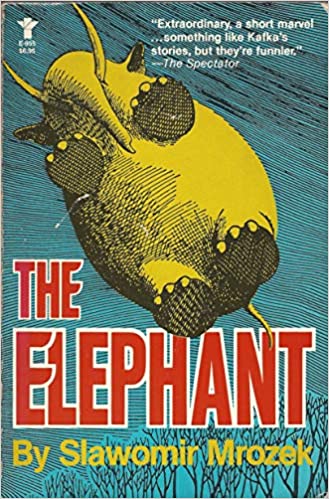The Elephant-Slawomir Mrozek (Translated from the Polish by Konrad Syrop)
Genre: Contemporary realistic fiction
At the Surface
level, ‘The Elephant’ is a simple story about how a small polish zoo
attempts to cut costs by fabricating an elephant, rather than adding real
elephant to the Zoo’s collection. But at another level, ‘The Elephant’ is satirical
allegory. This is aimed at the communist government that controlled Poland
at the time the story was written (1958).
Language:
Contemporary
Technical
device: Satirical allegory
Satire:
Literary works those critics/ridicules human follies, institutions, government
by depicting it in a humorous, sarcastic, or scornful way. The purpose of
satire is often to teach a lesson or encourage change.
Or
A literary
mode based on criticism of people and society through ridicule. The satirist
aims to reduce the practices attacked by laughing scornfully at them--and being
witty enough to allow the reader to laugh, also. Ridicule, irony, exaggeration,
and several other techniques are almost always present. The satirist may insert
serious statements of value or desired behavior, but most often he relies on an
implicit moral code, understood by his audience and paid lip service by them.
The satirist's goal is to point out the hypocrisy of his target in the hope
that either the target or the audience will return to a real following of the
code. Thus, satire is inescapably moral even when no explicit values are
promoted in the work, for the satirist works within the framework of a widely
spread value system. Many of the techniques of satire are devices of
comparison, to show the similarity or contrast between two things. A list of
incongruous items, an oxymoron, metaphors, and so forth are examples
Allegory:
An allegory is a simple story, such as a fable or parable, whose major purpose
is to teach a moral lesson. An allegory can always be read on two levels – one
literal, the other symbolic. The underlying meaning can be parallel to, but
different from, the surface meaning.
Or
A
figurative work in which a surface narrative carries a secondary, symbolic or
metaphorical meaning.
Theme:
Deception
Deception
and its repercussions emerge as the central themes of the story, especially the
conflict of the state versus its people. The zoo is substandard in this communist
society in which appearances mean everything and in which major inadequacies
are overlooked because they would, if articulated, reflect badly on the
bureaucracy governing the country.
Conflict:
Man versus Man, Man versus State
Setting:
Zoo in Poland
Point
of View: The third-person omniscient narrative focuses
on the ambitious and self-serving director of the Zoological Gardens in a
provincial Polish town.
Third Person Omniscient
This style
is often frowned upon, and comes under fire from many writing style
authorities. Nine times out of ten at least, it's a liability to the book. But
there are a few stories that must use this style and come out better for it.
Since these stories are few and far between, writers are encouraged to use careful
judgment, and avoid omniscient viewpoint unless it would add something
extraordinary.
First,
some definitions: third person omniscient is not to be confused with using
multiple viewpoints. A writer can have multiple viewpoints in a piece of
fiction and can be writing in third person without using third person
omniscient. This is covered later on. Third person omniscient is an older
narrative style in which a single viewpoint contains all characters and
perspectives.
The key
point to remember in using third person omniscient narration is consistency.
Narrative shifts shouldn't happen randomly; they should have a sense of order
and rhythm that remains consistent throughout the story.
SUMMARY
Surface level:
The story
starts with a description of the zoo director. "He regards his animals
simply as stepping stones of his career. He is careless about the educational
value of his establishment." Being in a remote town the zoo is not funded
and therefore was "lacking all the important animals". On the anniversary
of the liberation of Poland, the zoo was informed that it was receiving an
elephant. The staffs of the zoo were very happy but they were surprised that
their director was preparing a plan for am more economical elephant. The
director had written a letter to the higher authority suggesting an economical
elephant made of rubber. Thus, money can be saved to buy a jet plane or to
conserve some church monuments. His letter was officially sanctioned and the
ministry had approved the idea.
The
director began the preparation of the rubber elephant.
The
director, who has 3000 rabbits but no elephant, thinks the most important thing
is his promotion in his career. So he thinks it doesn’t matter what children
are affected by their seeing a spurious elephant. He orders the zoo keepers to
blow air into a rubber elephant and to make it as if a real one. He, who was
indifferent to educational importance and cared about only his own career,
planned to make an elephant out of rubber instead of having a real elephant for
saving the cost significantly. He thought that they could fill it with air and
place it behind the railings, and that nobody would notice it was not real
because elephants are sluggish animals.
Two
keepers were assigned to blowing the huge rubber elephant really hard; however,
they could not make it big enough to look like a real elephant. They got
exhausted and came up with an idea that they can fill it with gas and they did.
The zoo keepers regarded their duties in a purely bureaucratic manner and do not
examine the heart of the matter, but followed only the directives of their
superior.
The
elephant was placed with a big notice proclaimed: Particularly sluggish, next
to the monkey’s cage in front of a real rock. And the elephant hardly moved. A
party of children from the local school came to see the elephant. At the moment
the teacher was explaining to the children how heavy an elephant is, the rubber
elephant filled with gas rose in the air and was blown away by a gust of wind
disappearing above the trees. Later the elephant was found in the nearby
botanical garden being punctured by landing on a cactus. The children who
witnessed the scene turned into hooligans and no longer believed in elephants.
Satirical allegory:
The story
exposes the corrupt communist government and its officials in Poland. It
reveals the struggle between the citizens and the policies of communist regime.
‘The Elephant’ can be termed as a satire on the follies of the communist
government. It indirectly criticizes the drawbacks of communism and the
policies implemented in Poland after the Second World War
It is an
allegory because each character in the story symbolizes something. The elephant
is fabricated by the directors of the Zoo symbolizes the manifesto of the
communist government. Like the elephant the communist government is also
beautiful when seen from outside with its almost utopian principles to provide
everyone equality. But deep within the politicians themselves are corrupt and
lead to the destruction of the state. These officials feel that they could fool
the public by replicating the “real thing” but in reality they are only making
fool out of themselves.
Communism
has brought only atrocities and corruption into Poland. It hasn’t brought
relief to the majority as promised, nor has it ended oppression as purposed.
The metaphorical symbol in the story symbols in the story gives us clear image
of the leaders holding the absolute monopoly in power and thus using forces to
keep it concealed. The underlying meaning attached to the different abnormal animals
in the zoo could be a way to symbolize their acts – the short necked giraffe
can be the officials cut off from seeing what exactly the communist politicians
were up to. The badgers, who have lost their burrows, could be the officials
who have lost their post for going against their leaders. The whistlers could
be the revolutionist or the critics, who wanted to bring out the truth of the
politicians but reluctantly whistled, because of their lives at stake. These
short comings shouldn’t have been allowed especially as the zoo was often
visited by school children.
The
communist manifesto looks attractive and magnificent from outside, the way it
is designed but internally it is hallow just like the rubber elephant which was
inflated with air. The zoo represents the country, animals, and the defective
policies of the government. The director represents the corrupt officials who
are manipulative, self centered and least bothered about the well-being,
sentiments and feelings of the innocent people. They were selfish and concerned
about their own career rather than the welfare of the state.
The two
keepers represent the lower working class. These innocent people have to carry
out their duties according to the whims and fancies of the higher officials;
they were also involved in the corruption and manipulation of the government
policies.
The children represent the innocent citizens who
have a lot of faith in the government as per the promises made in the communist
manifesto. However, when they know the reality and motives of the government
they are enraged, become violent and turn against the government.Points to Remember about “The Elephant”:
- That Slawomir Mrozek, the author of this story, is a Polish dramatist and short-story writer
- That ‘Elephant’ is a contemporary realistic fiction and a beautiful satirical (political) allegory.
- That this story is satirizing the then communist government of Poland.
- That the story has two levels of meaning – the textual meaning creating lots of humour and the symbolic meaning criticizing the corrupt officials and the government.
- That the author is the ‘narrator’ in this story and the story has been written in ‘third person point of view’.
- That ‘Deception and its effects’ and ‘criticizing the corrupt officials and highlighting the corrupt system and government’ are the most prominent themes of this story.
- That a small zoological garden in the provincial town of Poland is the setting of this story.
- That ‘the director vs his selfish motives’ is the internal conflict in this story.
- That ‘the director vs other employees in the zoo’ and ‘the state vs the people’ are the prominent external conflicts in this story.
- That ‘Satire’ is a form of literary work which intends to criticize or ridicule the mistakes, wrongdoings and follies of a person, society or institution in a humorous and sarcastic manner with a positive intention to bring in some positive change by creating awareness.
- That an ‘Allegory’ is a story or visual image with a parallel and distinct second meaning hidden behind its literal or visible meaning. ‘Personification’ is the principal technique used in this kind of writing.
Symbolism used in “The Elephant”:
Sl. No.
|
LITERAL TERMS
|
SYMBOLIC MEANING
|
1
|
The zoo
|
The country Poland
|
2
|
The
Director of the Zoo
|
Representing
the communist government of Poland
|
3
|
Animals with different problems /deficiencies in the zoo
|
Government policies having defect and weakness of various kinds/The
underlying meaning attached to the different abnormal animals in the zoo
could be a way to symbolize their acts – the short necked giraffe can be the
officials cut off from seeing what exactly the communist politicians were up
to. The badgers, who have lost their burrows, could be the officials who have
lost their post for going against their leaders. The whistlers could be the
revolutionist or the critics.
|
4
|
The
school children
|
The
common innocent people of the country
|
5
|
The Elephant
|
The constitution, the manifesto or the policy of the Polish
communist government
|
6
|
The
flying Elephant
|
The
deceiving and deception involved in the government’s manifestos and policies
|
7
|
The officials
|
The corrupted officials in the communist government working
foolishly
|
8
|
The
two zoo keepers
|
The
corrupted officials who support their boss blindly and irrationally
|
9
|
The teacher
|
The innocent victim of a corrupt system
|
10
|
Misbehaving
students
|
Anger
of the common men coming out in various violent manners
|
Questions and Answers
1. What are
some of the specialities of the zoological garden in the provincial town?
This zoological park is located in a provincial
town of Poland. The park does not have so many animals such as badger, giraffe,
elephant etc. And those animals which are there in the park are having so many
shortcomings and drawbacks. Many animals in the park are made of rubber.
2. With what
intention did the Director write a letter to Warsaw?
The Director wrote the letter to Warsaw
regarding the allocation of an elephant in the zoo. His intention was to
forward a plan to obtain an elephant by more economic means. That is why he
proposed to have a rubber elephant with appropriate size and colour. He sent
this proposal with a satisfaction that he was contributing to his country in
reducing the expenditure and use the saved money for some better purpose and
cause for the country.
3. What did
they plan to address the problem of immobility of the elephant?
Very cleverly but stupidly at the same time
they decided to put a board declaring the elephant particularly lazy and
sluggish which hardly moved.
4. The
Director’s proposal was promptly approved. What does it symbolize?
This event simply symbolizes that not only the
Director but even the superior officers and authorities were equally
incompetent and stupid. They approved the proposal without analysing it
properly. They did not even bother for the impact of such stupidity on the
common men and children who used to frequent the park for educational purpose.
5. “The
Director of the Zoological Garden is not at all worthy of the post.” Explain
the statement with supportive argument from the story.
From the very beginning of the story its
evidently clear that the Director does not bother for anything else except his
own benefit and promotion. Animals in the zoo are just the stepping stones on
his way to success. This zoological garden is particularly meant for educational
purpose but the Director is totally indifferent to this purpose and cause. He
always thinks how to get promotion and bonus. For him educational purpose or
society or children do not matter. Thus it’s very much clear that he was not
worthy of the post.
6. Explain
the symbolical significance of ‘Rubber elephant filled with gas’.
In this story everything is symbolically used
with a satirical intent in order to criticize something else at the political
front. The rubber elephant filled with gas symbolically represents the
artificial existence of fake and deceiving laws and manifestos of the communist
government of Poland. It also symbolises the hollowness of these manifestos
having very weak substantiality.









2 Comments
What is the relationship between character and zoo director
ReplyDeleteIf you are the director of the zoo how would you handle the failure of the rubber elephant?
ReplyDelete